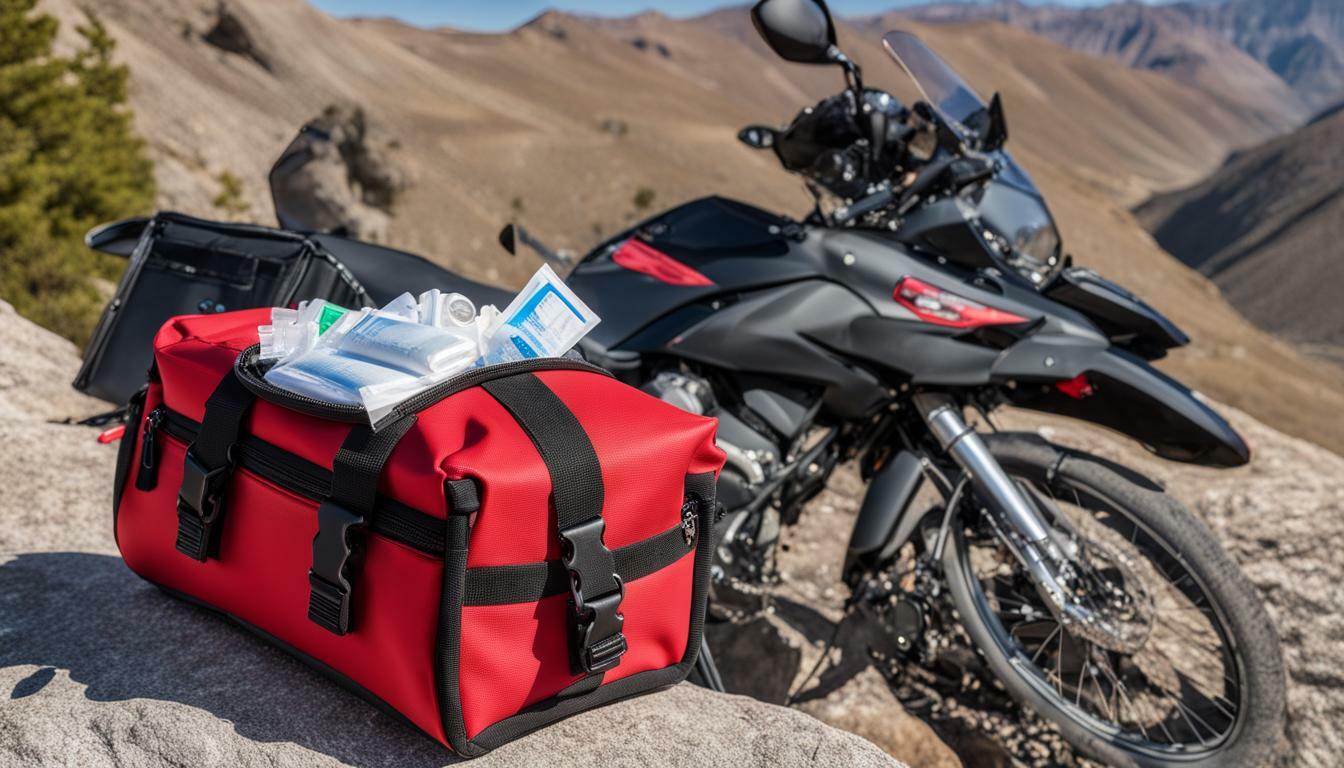Embarking on a motorcycle road trip is an exhilarating adventure, but it’s important to prioritize safety and health on two wheels. Accidents can happen, and being prepared with a first aid kit can make all the difference. A well-stocked first aid kit can provide peace of mind and quick access to necessary medical supplies in the event of an emergency.
When planning your motorcycle road trip, don’t forget to pack a first aid kit. It could be a lifesaver. In this section, we’ll explore the importance of first aid kits for motorcycle road trips and how they can ensure a safe and enjoyable journey. We’ll cover essential items to include in your kit, tips for choosing the right one, and how to respond to common motorcycle injuries.
Whether you’re a seasoned rider or new to the motorcycle world, safety should always be a top priority. With the right first aid kit and equipment, you can be prepared for anything the road throws your way. Let’s dive into the essentials of motorcycle first aid kits and how they can keep you safe on your next road trip.
The Essentials of Motorcycle First Aid Kits
When planning a motorcycle road trip, it’s crucial to be prepared for any potential emergencies. This is where a well-stocked motorcycle first aid kit comes in, containing essential items that can help address injuries and health issues that may arise on the road.
Motorcycle first aid kits should contain basic medical supplies designed specifically for motorcycle emergencies. These include:
| Item | Purpose |
|---|---|
| Adhesive bandages | To cover small cuts and scrapes |
| Gauze pads | To stop bleeding and clean wounds |
| Antiseptic wipes | To clean and disinfect wounds |
| Tweezers | To remove splinters or debris from wounds |
| Instant cold pack | To reduce inflammation and swelling |
| Disposable gloves | To protect against infection and prevent bloodborne pathogen transmission |
| Emergency blanket | To keep riders warm in case of an accident or breakdown |
| Tourniquet | To control severe bleeding in case of a serious injury |
It’s important to note that the contents of a motorcycle first aid kit may vary depending on the rider’s specific needs and the nature of the road trip. For example, if the trip involves camping or off-roading, additional supplies such as insect repellent, sunscreen, and burn gel may be necessary.
Overall, a well-stocked motorcycle first aid kit can help ensure that riders are prepared for any potential emergencies that may arise on the road. By having the necessary supplies on hand, riders can be properly equipped to respond to injuries and maintain their health on two wheels.
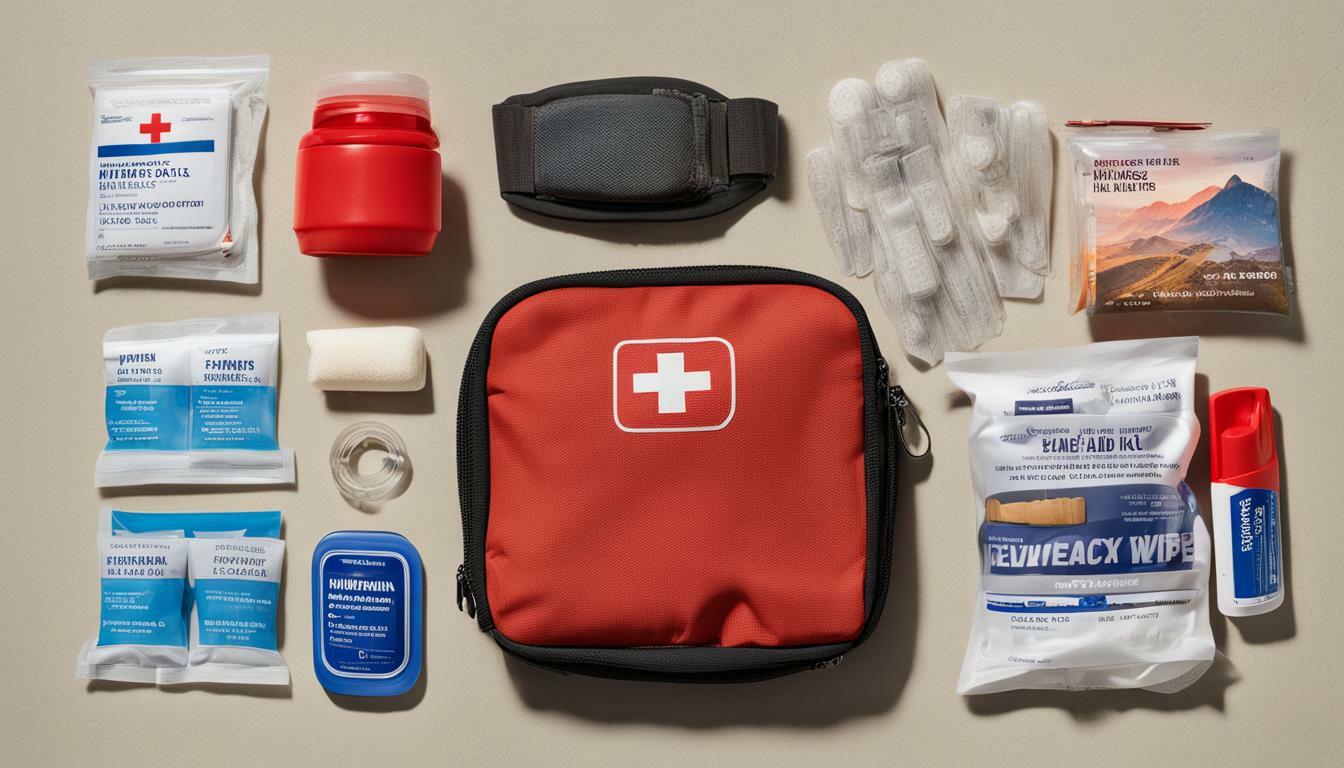
Tips for Choosing the Right Motorcycle First Aid Kit
When selecting a first aid kit for your motorcycle road trip, it is important to consider factors such as the size of the kit, the types of injuries it can handle, and the durability of its contents. A motorcycle first aid kit should be compact enough to fit in your saddlebag or backpack, yet comprehensive enough to address a range of potential emergencies.
When it comes to motorcycle first aid supplies, some key items to look for include adhesive bandages, gauze pads, medical tape, scissors, gloves, and antiseptic wipes or spray. A first aid kit with prepackaged items can also be helpful as they are often organized by specific injury type, such as burns, cuts or scrapes.
Another important consideration is motorcycle safety equipment, such as a high-visibility vest, reflective tape, and a compact emergency whistle. These items can help ensure that you are visible to other motorists and can attract attention in the event of an emergency.
It may also be beneficial to choose a first aid kit that includes a comprehensive first aid manual or sign up for a basic first aid course to increase your knowledge of emergency first aid. This can help you to be better prepared and more confident in handling unexpected medical emergencies on the road.
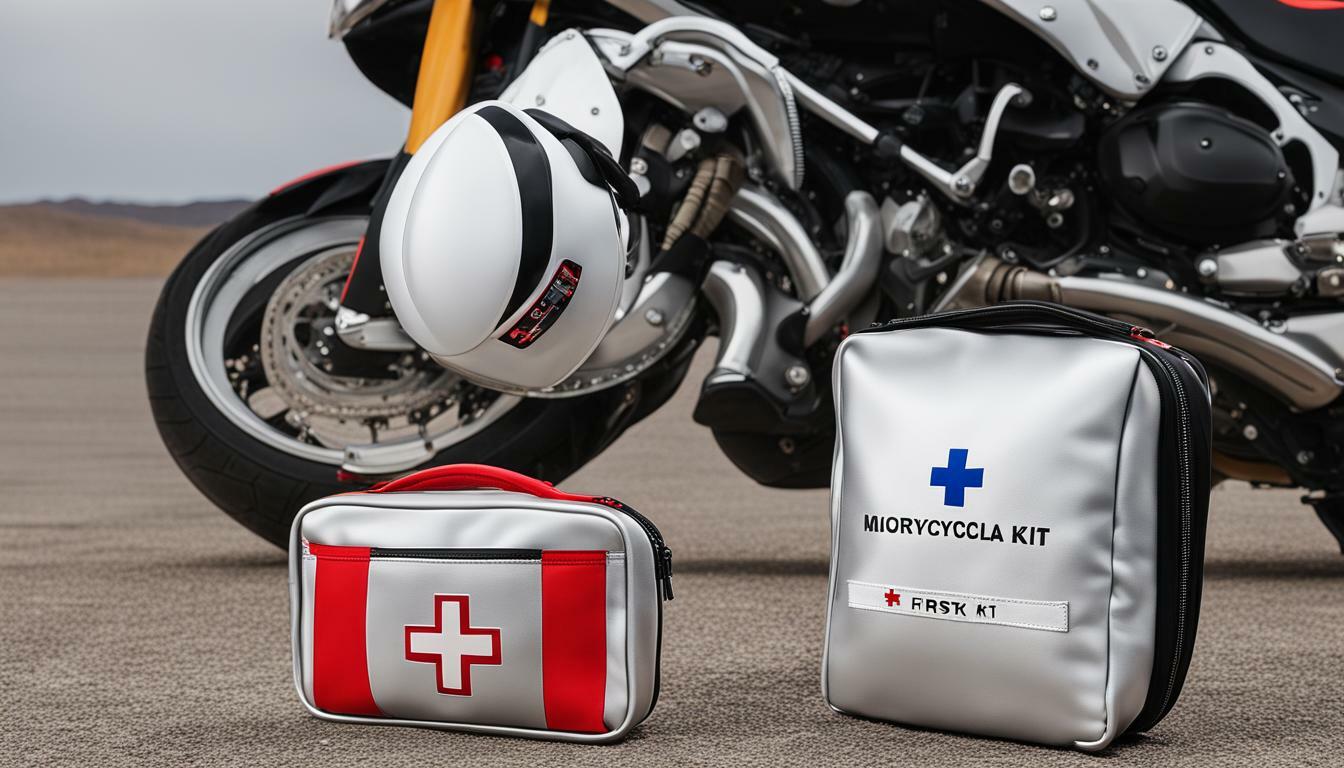
Overall, choosing the right motorcycle first aid kit involves finding a balance between size, comprehensiveness, and durability. By selecting a kit with the right supplies and equipment, you can ensure that you are prepared for any medical emergency that may arise on your motorcycle road trip.
Packing Your First Aid Kit for a Motorcycle Road Trip
When packing for a motorcycle road trip, it’s essential to include a first aid kit. A well-stocked kit can help you manage injuries and illnesses that may occur while camping or on the road. Here are some tips to consider when packing your first aid kit for a motorcycle road trip.
Consider the Size and Weight
First aid kits come in various sizes, so choose one that suits your needs and the size of your motorcycle. A smaller kit may be more portable, but it may not have all the necessary supplies. Ensure that the kit fits in a secure place on your bike to avoid damage or loss. Keep in mind the weight of the kit, especially if you have limited storage space on your motorcycle.
Include Motorcycle First Aid Essentials
You should pack your first aid kit with supplies that can address common injuries and illnesses that can happen on the road. For example, in case of a motorcycle accident, you need dressing pads, wound closure strips, and sterile gloves. In case of extreme weather conditions, insect repellents, sunscreen, and lip balm can be helpful. Additionally, over-the-counter medications such as painkillers, antihistamines, and antacids can be useful for minor ailments.
| First Aid Kit Essentials for a Motorcycle Road Trip | Quantity |
|---|---|
| Dressing pads | 5-10 |
| Wound closure strips | 10 |
| Sterile gloves | 2 pairs |
| Insect repellents | 1 bottle |
| Sunscreen | 1 bottle |
| Lip balm | 1 |
| Painkillers | As needed |
| Antihistamines | As needed |
| Antacids | As needed |
Consider Motorcycle Camping Safety
If you plan to camp during your motorcycle road trip, consider including additional items that prioritize camping safety. For example, you may want to bring a camping stove, a flashlight, and a whistle. In case of an emergency where you need to signal for help, a whistle can quickly draw attention. Ensure that you keep your first aid kit and camping gear in waterproof containers to keep them safe in case of adverse weather.
Don’t forget to periodically review and restock your first aid kit during your trip as needed. Properly maintaining your first aid kit can ensure it’s ready for any situation and provide peace of mind for a safe motorcycle road trip.
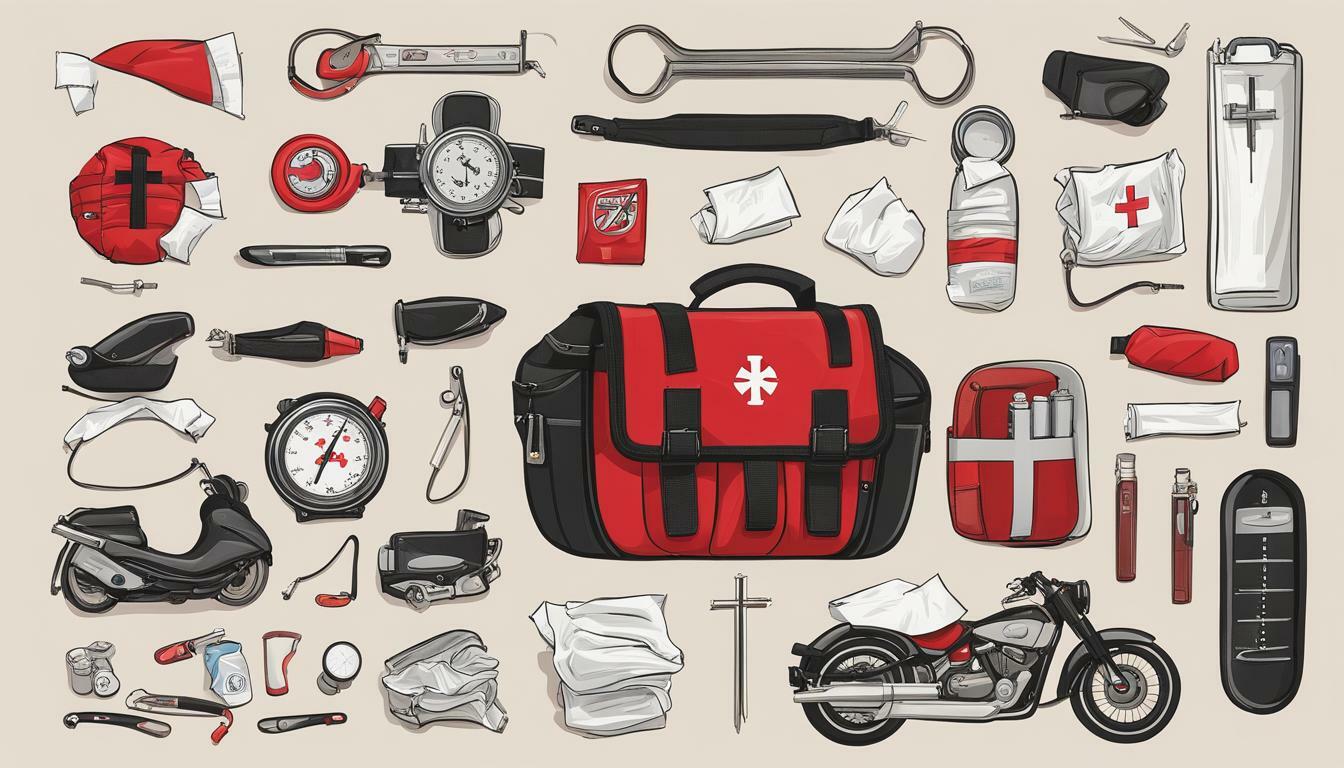
First Aid Training for Motorcycle Riders
When embarking on a motorcycle road trip, it is crucial to prioritize safety and be prepared for any potential emergencies. One of the best ways to ensure this is to undergo first aid training.
While it may not be a legal requirement, having basic medical knowledge and skills can prove invaluable in a motorcycle emergency. In fact, it could make the difference between life and death in certain situations.
Aside from handling physical injuries, first aid training can also teach riders how to deal with shock, manage breathing difficulties, and perform CPR. These are all critical skills that could mean the difference between a serious injury and a minor one.
Another benefit of first aid training is the confidence it instills in riders. Knowing that you are equipped to handle emergencies can significantly reduce anxiety and enhance the overall enjoyment of the trip.
Overall, investing in first aid training is an essential aspect of motorcycle road trip safety. It is a small investment that could make a significant impact on your health and wellbeing on the road.
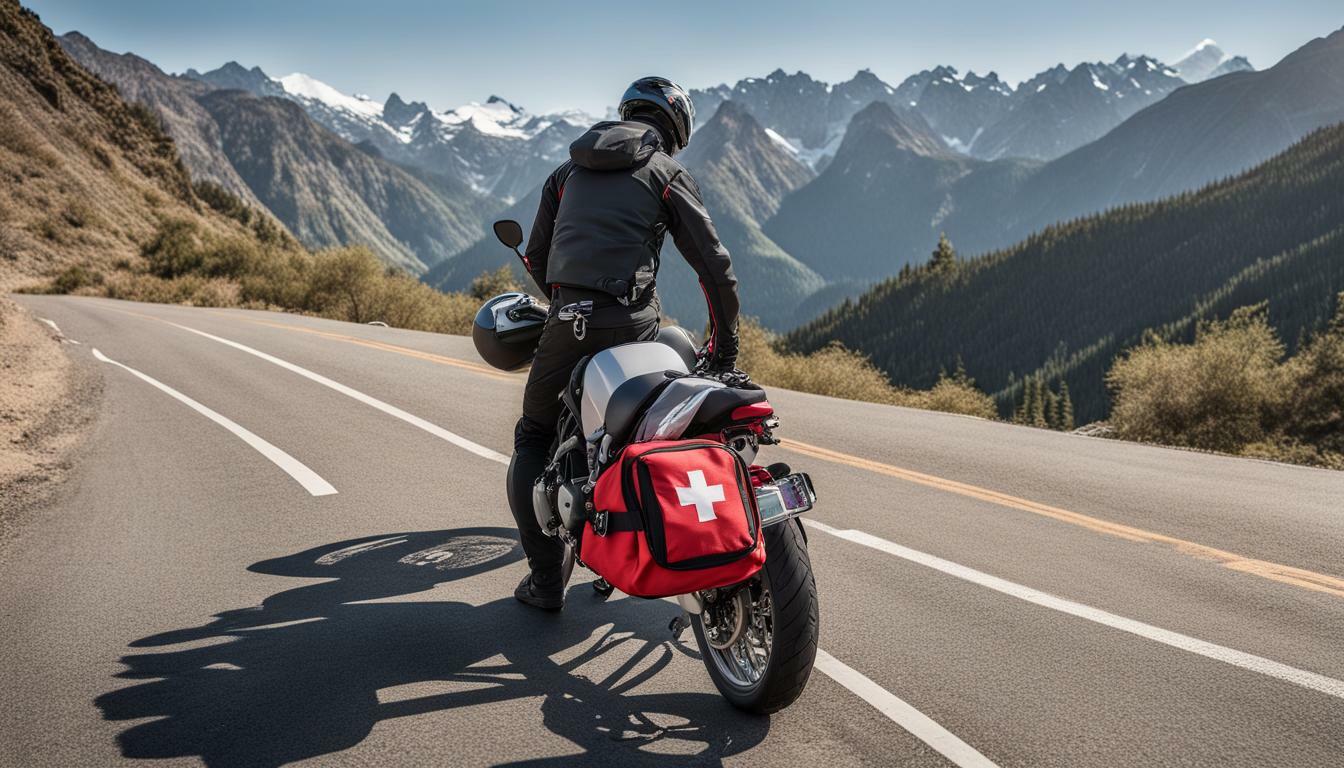
Responding to Common Motorcycle Injuries
Motorcycle accidents can result in a range of injuries, and riders should be prepared to respond quickly and effectively. Here are some common motorcycle injuries and how to treat them:
Road Rash
One of the most common injuries in motorcycle accidents is road rash, which occurs when a rider’s skin scrapes against the road surface. To treat road rash, first clean the affected area with mild soap and water. Then, apply antibiotic ointment and cover the wound with a sterile bandage or dressing. If the wound is extensive or shows signs of infection, seek medical attention.
Fractures
Fractures, or broken bones, can occur when a rider falls off their motorcycle or collides with another object. If you suspect a fracture, stabilize the affected limb and seek medical attention immediately. Avoid moving the injured person unless it’s absolutely necessary, as this can make the injury worse.
Head Injuries
Head injuries are a serious concern for motorcycle riders, as they can lead to long-term neurological problems or even death. If a rider has experienced a blow to the head, even if they feel fine, they should receive medical attention immediately. Always wear a helmet when riding, as this can greatly reduce the risk of head injury.
Broken Ribs
Broken ribs can result from the impact of a motorcycle accident. If a rider complains of chest pain or difficulty breathing, suspect a broken rib and seek medical attention immediately. Treatment often involves immobilization and pain management.
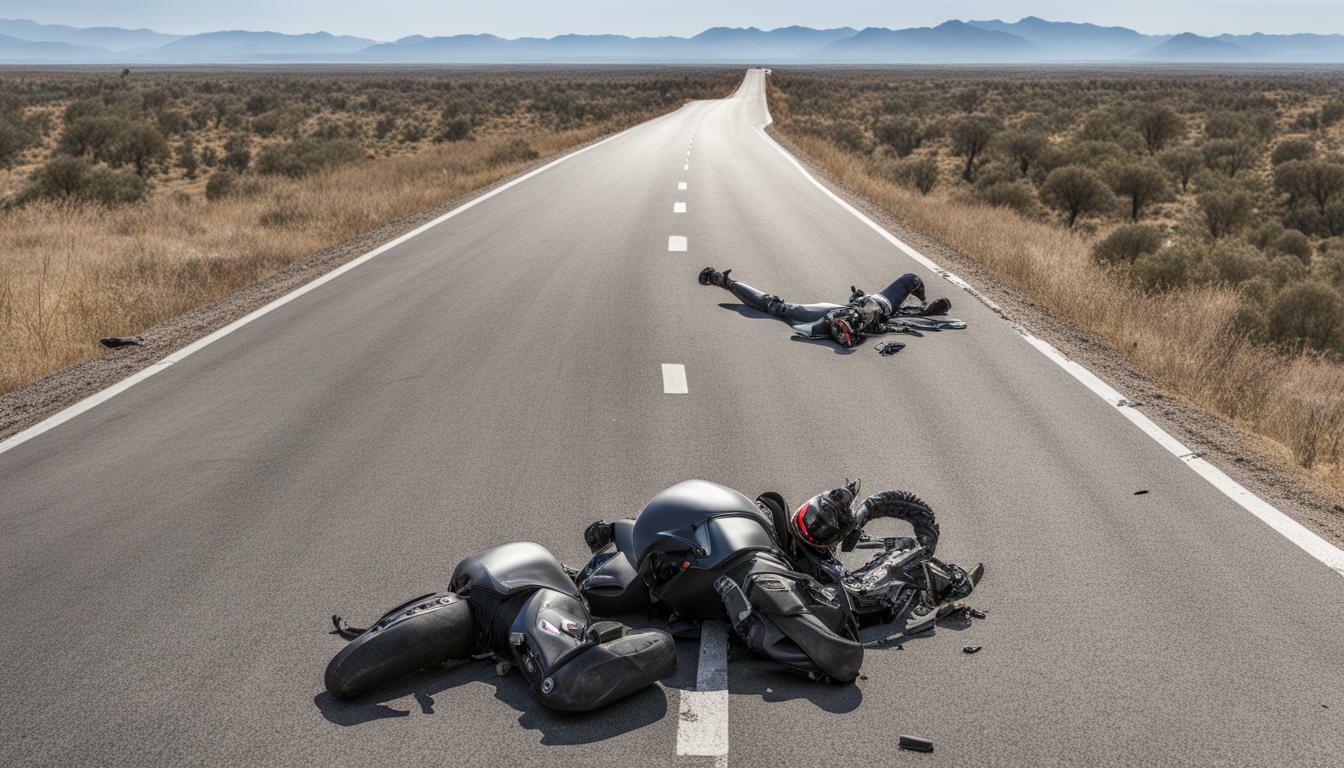
Remember, the key to responding to injuries is to stay calm and act quickly. Be sure to keep a well-stocked first aid kit on hand and be prepared to contact emergency services if necessary. By prioritizing your health and safety on motorcycle road trips, you can enjoy the open road with peace of mind.
Emergency Contacts and Communication
When you’re on a motorcycle road trip, it’s crucial to have emergency contacts readily available in case of any accidents or medical emergencies. Before you hit the road, make sure to have a list of emergency contacts saved in your phone and a hard copy in your first aid kit, including the local emergency services number. It’s also a good idea to share your itinerary with family or friends and let them know when you expect to arrive at your destination each day.
In addition to having emergency contacts, it’s important to have effective communication methods in case of an emergency. Carry a fully charged mobile phone with you and consider downloading emergency apps that allow you to quickly call for help and share your location.
It’s also important to be aware of your surroundings and communicate effectively with other motorists on the road. Make sure your motorcycle is equipped with proper lighting and use hand signals to indicate your movements when necessary. Defensive riding and staying visible can help prevent accidents and keep you safe on the road.

Remember, staying prepared and communicating effectively can make all the difference when it comes to motorcycle road trip safety and handling emergencies.
Preparing for Medical Emergencies on the Road
When embarking on a motorcycle road trip, it’s important to prioritize your health on two wheels in case of motorcycle emergencies. This includes preparing for medical emergencies that may arise on the road. Here are some tips for staying prepared:
Manage Chronic Conditions
If you have a pre-existing medical condition, make sure to bring enough medication to last the duration of your trip, plus a few extra days just in case. Keep your medication in a waterproof container and store it in an accessible place, such as a tank bag or saddlebag. Carry a medical ID bracelet or card that identifies your condition in case of an emergency.
Plan for Unexpected Health Issues
When packing your first aid kit, include items such as over-the-counter pain relievers, antihistamines, and anti-diarrheal medication. These can come in handy for unexpected health issues that may arise on the road. If you have a history of allergies or other medical conditions, consider packing a pre-filled epinephrine auto-injector and any other necessary emergency medications.
Carry a First Aid Guide
In addition to your first aid kit, carry a first aid guidebook that can help you respond to medical emergencies on the road. Familiarize yourself with the guidebook prior to your trip so that you can respond quickly and effectively in an emergency situation.
Stay Hydrated and Nourished
Dehydration and malnutrition can exacerbate medical conditions and increase the risk of motorcycle emergencies. Make sure to stay hydrated by drinking plenty of water and packing electrolyte replacement supplements. Bring non-perishable snacks and food that will sustain you throughout your journey.
By following these tips, you can stay prepared for any medical emergency that may arise on your motorcycle road trip. Remember, prioritizing your health on two wheels is essential for safe and enjoyable motorcycle road trip safety.

Staying Safe on British Roads
When it comes to motorcycle road trip safety, having the right equipment is essential. Beyond a well-stocked first aid kit, investing in quality motorcycle safety equipment can help prevent accidents and minimize potential injuries. Here are some tips for staying safe on British roads:
Wear Proper Safety Gear
Wearing the appropriate safety gear can prevent serious injuries in the event of an accident. This includes a full-face helmet, protective eyewear, gloves, and boots that cover the ankles. Additionally, consider wearing protective clothing, such as a leather suit or jacket, to reduce the risk of road rash if you fall. Remember, safety gear should fit properly and be in good condition.
Stay Visible
One of the biggest dangers for motorcyclists is not being seen by other drivers. To increase your visibility on the road, wear brightly colored or reflective clothing and add reflective tape to your motorcycle. Use your headlights, even during the day, and avoid riding in blind spots or weaving in and out of traffic.
Practice Defensive Riding
Defensive riding means anticipating potential hazards and being prepared to take action. Always obey traffic laws and signal your intentions to other drivers. Maintain a safe following distance and be aware of your surroundings at all times. Keep an eye out for obstacles in the road, such as potholes or debris, and adjust your speed accordingly.
Maintain Your Motorcycle
A well-maintained motorcycle is less likely to break down or suffer from mechanical failures. Regularly inspect your motorcycle, including brakes, tires, lights, and signals, and address any issues promptly. Additionally, consider adding safety features, such as anti-lock brakes or traction control, to your motorcycle.
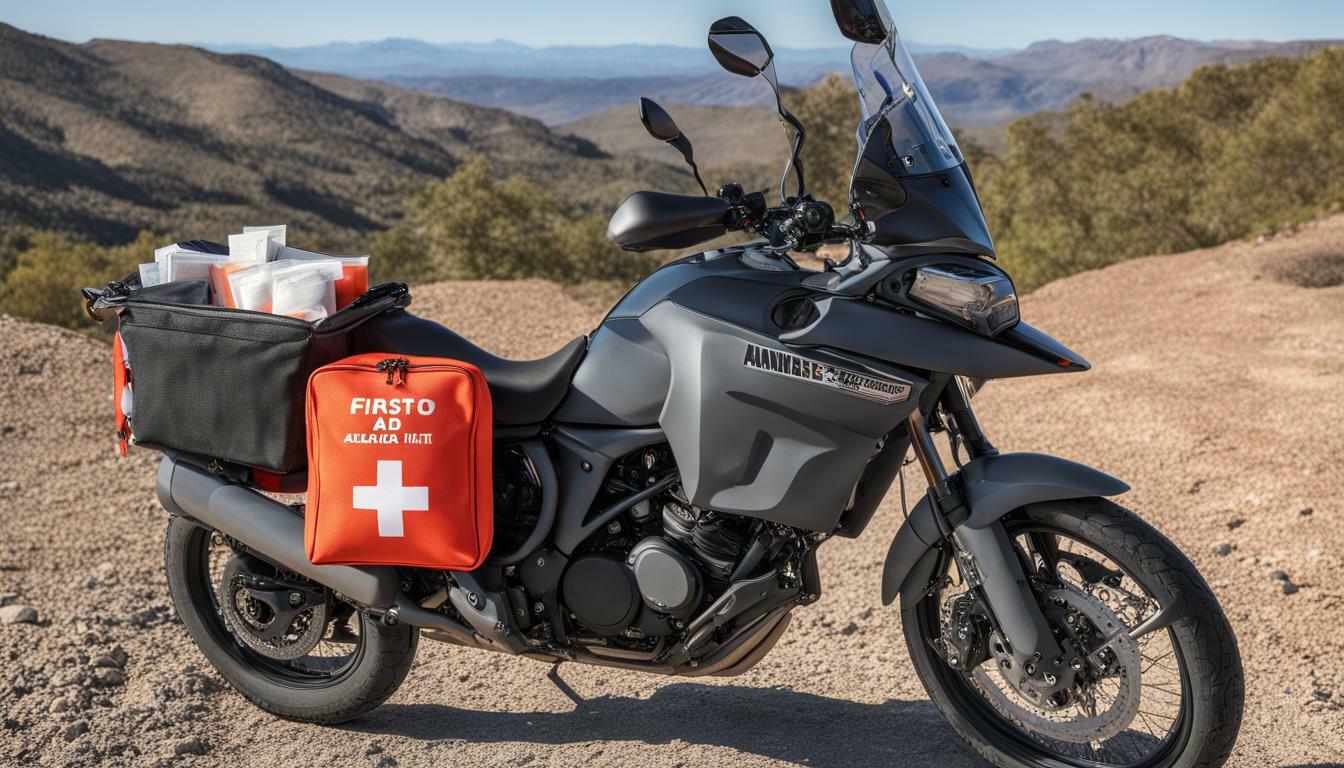
By following these tips for motorcycle road trip safety and investing in quality safety equipment, you can help ensure a safe and enjoyable journey on British roads.
Maintaining Your First Aid Kit and Equipment
Investing in a quality first aid kit and safety equipment is crucial for any motorcycle road trip. However, it’s equally important to ensure that your first aid kit and equipment are well-maintained so that they are always ready to use in an emergency. Here are some essential tips on maintaining your first aid kit and motorcycle safety equipment:
Regular Inspections
Inspect your first aid kit and safety equipment frequently, especially before any long road trips. Regular inspections will ensure that everything is in good working condition and that all of the items are present and accounted for. Check the integrity of the packaging, expiration dates of contents and cleanliness of the items. Protect your kit from direct sunlight and dry, temperature-controlled storage will ensure longevity.
Restocking Supplies
Keep your first aid kit well-stocked with all the essentials. It’s important to restock items that have been used, such as dressings, pills or medical devices. Regularly check that your kit is still complete. You might consider buying additional items that you find essential for your personal medical condition. You can get some advice at a pharmacy to customize your kit.
Keeping Your Equipment in Good Working Condition
Your safety equipment, such as helmets, boots, and gloves should also be well-maintained. Make sure to check for any signs of wear and tear and replace any damaged gear immediately. Clean helmets, visors, gloves and boots after each use to maintain their integrity and look.
By following these maintenance tips for your first aid kit and motorcycle safety equipment, you can rest assured that you are always prepared for any unexpected emergencies on your motorcycle road trips. Remember, a well-maintained first aid kit and safety equipment are crucial for a safe and enjoyable ride.
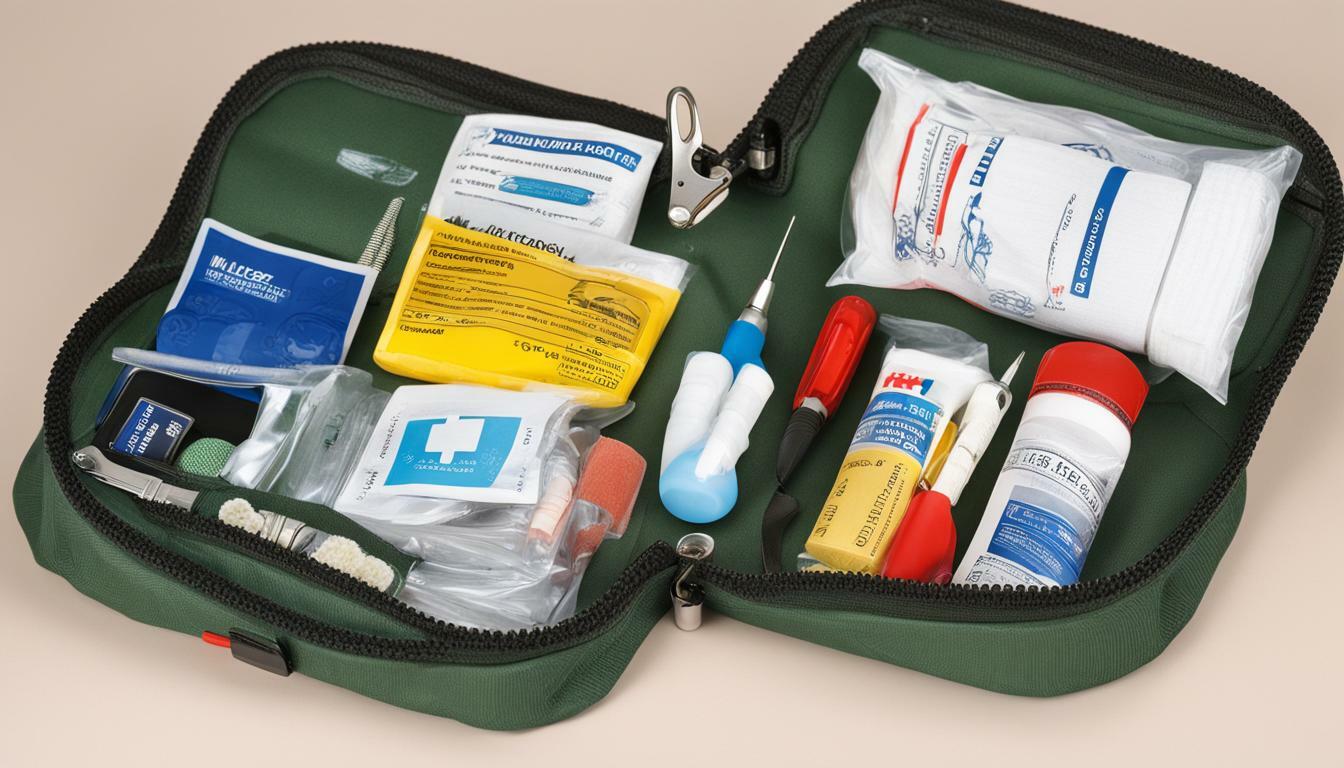
Conclusion
When it comes to motorcycle road trips, prioritizing your health is crucial for ensuring a safe and enjoyable journey. Investing in a quality first aid kit is an essential step for any rider.
In this article, we have discussed the key components of a motorcycle first aid kit and provided guidance on selecting the appropriate one for your needs. We have also covered practical advice on packing your first aid kit, first aid training for riders, responding to common injuries, and emergency contacts and communication.
Additionally, we have emphasized the importance of preparing for medical emergencies on the road and staying safe on British roads. It is important to remember that accidents can happen, and being prepared can make all the difference.
Finally, we have provided guidance on maintaining your first aid kit and other safety equipment on your motorcycle, as regular inspections and restocking supplies are crucial for ensuring their effectiveness.
